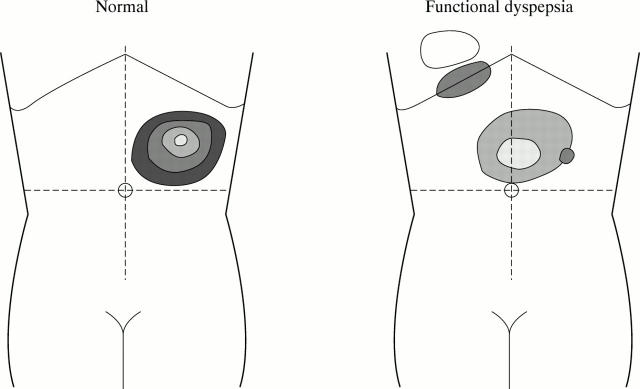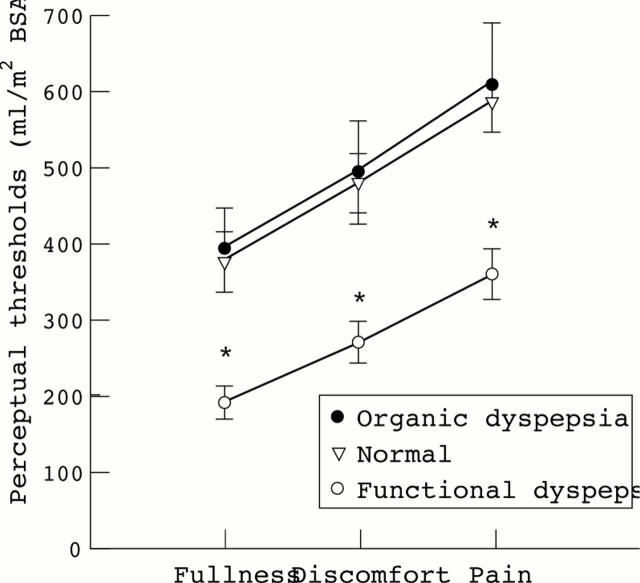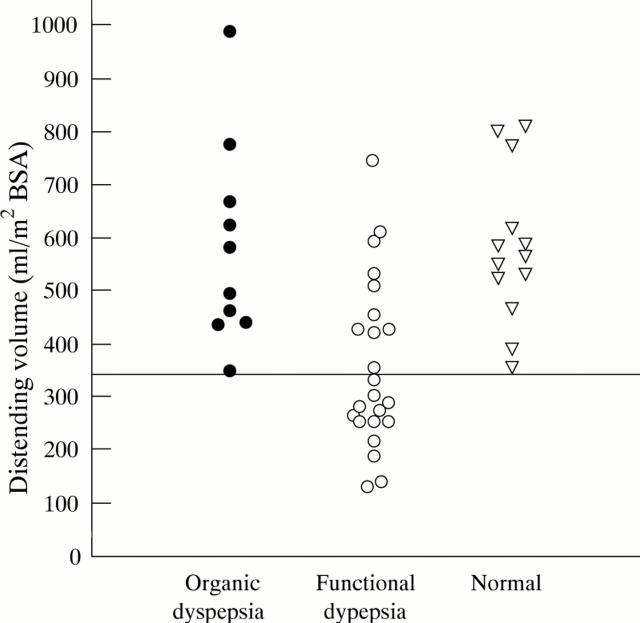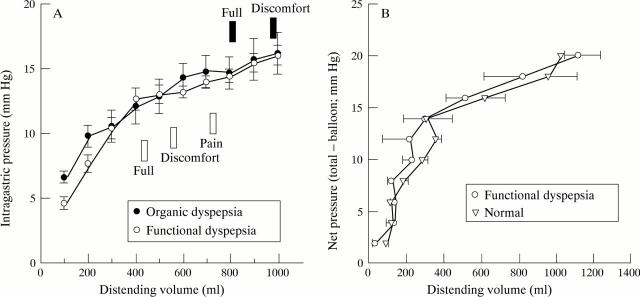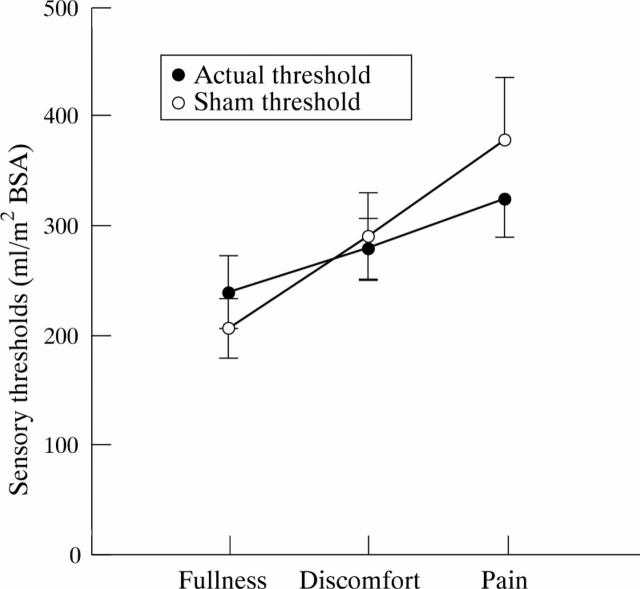Abstract
Background—Hypersensitivity of gastric afferent pathways may play an aetiological role in symptoms of functional dyspepsia. Aims—To determine whether patients with severe organic dyspepsia (associated with tissue irritation/injury) and those with functional dyspepsia (no detectable tissue irritation) differ in their perception of gastric distension and whether this difference is reflected in differences in their gastrointestinal and psychological symptoms. Methods—Perceptual thresholds, referral patterns, and gastrointestinal and psychological symptoms were compared in 23 patients with functional dyspepsia, 10 organic dyspeptics, and 15 healthy controls. Results—Fifteen (65%) functional dyspeptics and no organic dyspeptics had reduced perceptual thresholds for fullness, discomfort, or pain (odds ratio (OR) 19.56, 95% confidence interval (CI) 1.95to 476.09, p=0.0017). Either reduced perceptual thresholds or altered referral was found in 20 (87%) functional dyspeptics and four (20%) organic dyspeptics (OR 10.0, 95% CI 1.34 to 89.54,p=0.014). During sham distension fullness, discomfort and pain were reported by healthy controls, organic dyspeptics, and functional dyspeptics. A sham response of pain but no other sensation was more frequent among functional dyspeptics (43%) than healthy controls (7%) (OR 10.77, 95% CI 1.10 to 257.35, p=0.026). Gastrointestinal and psychological symptoms and gastric compliance were similar in the functional and organic groups. Conclusions—Alterations in the perception of gastric distension distinguishes between functional and organic dyspepsia, while symptoms do not. A total of 87% of functional dyspeptics studied had evidence of altered visceral afferent function. In this study population, psychological abnormalities or changes in compliance did not explain the findings.
Keywords: dyspepsia; hyperalgesia; visceral afferents
Full Text
The Full Text of this article is available as a PDF (144.4 KB).
Figure 1 .
Viscerosomatic referral during gastric distension. A typical referral pattern from a healthy control subject (also typical of the organic dyspeptics) and the corresponding pattern from a patient with FD.
Figure 2 .
Perceptual response to gastric distension (ramp). *p<0.01 for FD versus organic dyspeptics and healthy controls.
Figure 3 .
Pain thresholds during gastric distension (ramp). The cut off line for a normal pain threshold was selected to include all the healthy controls. This cut off was the mean −1.6 SD (90th percentile) (2/15 healthy controls did not report pain up to gastric volumes of 1500 ml).
Figure 4 .
Gastric compliance. (A) Ramp distension. Gastric compliance (dV/dP) at each volume was the same in functional dyspeptics, organic dyspeptics, and healthy control subjects (not shown for clarity). Gastric perceptual thresholds in relation to the pressure/volume curve are indicated for functional dyspeptics (open boxes) and organic dyspeptics (solid boxes). (B) Phasic distension. Gastric compliance was the same for functional dyspeptics and healthy controls at each pressure tested.
Figure 5 .
Perceptual thresholds during sham distension. Mean perceptual threshold volumes were measured for all subjects during actual gastric distension and during sham distension.
Selected References
These references are in PubMed. This may not be the complete list of references from this article.
- Bradette M., Pare P., Douville P., Morin A. Visceral perception in health and functional dyspepsia. Crossover study of gastric distension with placebo and domperidone. Dig Dis Sci. 1991 Jan;36(1):52–58. doi: 10.1007/BF01300087. [DOI] [PubMed] [Google Scholar]
- David D., Mertz H., Fefer L., Sytnik B., Raeen H., Niazi N., Kodner A., Mayer E. A. Sleep and duodenal motor activity in patients with severe non-ulcer dyspepsia. Gut. 1994 Jul;35(7):916–925. doi: 10.1136/gut.35.7.916. [DOI] [PMC free article] [PubMed] [Google Scholar]
- Fjøsne U., Kleveland P. M., Waldum H., Halvorsen T., Petersen H. The clinical benefit of routine upper gastrointestinal endoscopy. Scand J Gastroenterol. 1986 May;21(4):433–440. doi: 10.3109/00365528609015159. [DOI] [PubMed] [Google Scholar]
- Johnstone F. R., Holubitsky I. B., Debas H. T. Post-gastrectomy problems in patients with personality defects: the "albatross" syndrome. Can Med Assoc J. 1967 Jun 17;96(24):1559–1564. [PMC free article] [PubMed] [Google Scholar]
- Jänig W., Morrison J. F. Functional properties of spinal visceral afferents supplying abdominal and pelvic organs, with special emphasis on visceral nociception. Prog Brain Res. 1986;67:87–114. doi: 10.1016/s0079-6123(08)62758-2. [DOI] [PubMed] [Google Scholar]
- Lembo T., Munakata J., Mertz H., Niazi N., Kodner A., Nikas V., Mayer E. A. Evidence for the hypersensitivity of lumbar splanchnic afferents in irritable bowel syndrome. Gastroenterology. 1994 Dec;107(6):1686–1696. doi: 10.1016/0016-5085(94)90809-5. [DOI] [PubMed] [Google Scholar]
- Mansi C., Mela G. S., Savarino V., Mele M. R., Valle F., Celle G. Open access endoscopy: a large-scale analysis of its use in dyspeptic patients. J Clin Gastroenterol. 1993 Mar;16(2):149–154. [PubMed] [Google Scholar]
- Mayer E. A., Gebhart G. F. Basic and clinical aspects of visceral hyperalgesia. Gastroenterology. 1994 Jul;107(1):271–293. doi: 10.1016/0016-5085(94)90086-8. [DOI] [PubMed] [Google Scholar]
- Mayer E. A., Raybould H. E. Role of visceral afferent mechanisms in functional bowel disorders. Gastroenterology. 1990 Dec;99(6):1688–1704. doi: 10.1016/0016-5085(90)90475-g. [DOI] [PubMed] [Google Scholar]
- Mertz H., Naliboff B., Munakata J., Niazi N., Mayer E. A. Altered rectal perception is a biological marker of patients with irritable bowel syndrome. Gastroenterology. 1995 Jul;109(1):40–52. doi: 10.1016/0016-5085(95)90267-8. [DOI] [PubMed] [Google Scholar]
- Mertz H., Walsh J. H., Sytnik B., Mayer E. A. The effect of octreotide on human gastric compliance and sensory perception. Neurogastroenterol Motil. 1995 Sep;7(3):175–185. doi: 10.1111/j.1365-2982.1995.tb00223.x. [DOI] [PubMed] [Google Scholar]
- Plourde V., Lembo T., Shui Z., Parker J., Mertz H., Taché Y., Sytnik B., Mayer E. Effects of the somatostatin analogue octreotide on rectal afferent nerves in humans. Am J Physiol. 1993 Oct;265(4 Pt 1):G742–G751. doi: 10.1152/ajpgi.1993.265.4.G742. [DOI] [PubMed] [Google Scholar]
- Talley N. J., Phillips S. F., Wiltgen C. M., Zinsmeister A. R., Melton L. J., 3rd Assessment of functional gastrointestinal disease: the bowel disease questionnaire. Mayo Clin Proc. 1990 Nov;65(11):1456–1479. doi: 10.1016/s0025-6196(12)62169-7. [DOI] [PubMed] [Google Scholar]
- Talley N. J. Spectrum of chronic dyspepsia in the presence of the irritable bowel syndrome. Scand J Gastroenterol Suppl. 1991;182:7–10. doi: 10.3109/00365529109109530. [DOI] [PubMed] [Google Scholar]



